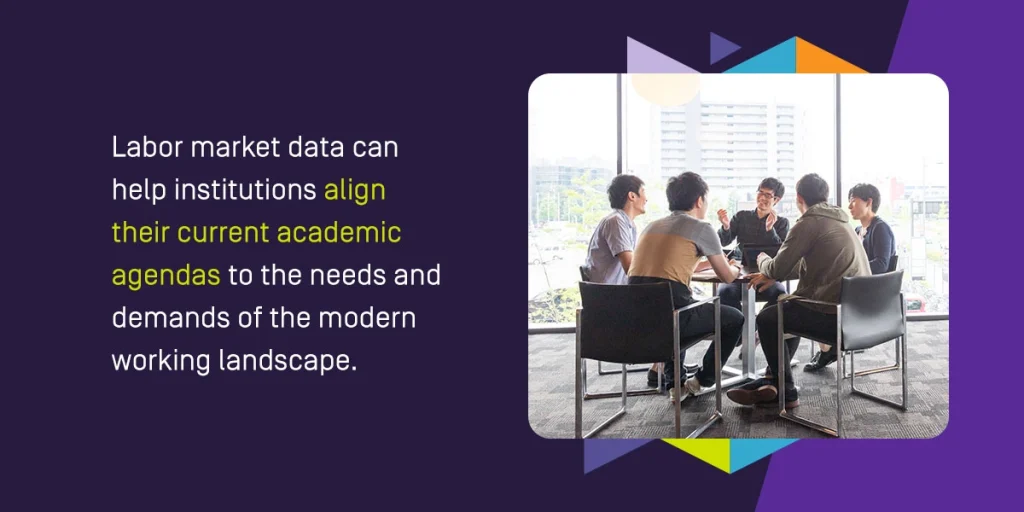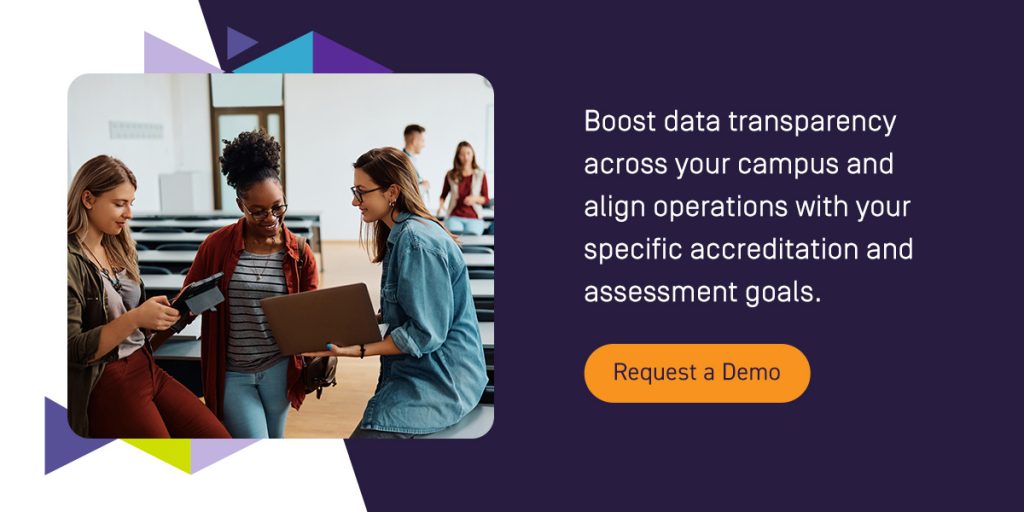



A higher education institution depends on its ability to adequately equip students with the skills and knowledge they need to cultivate meaningful, prosperous careers. Colleges and universities must stay attuned to the ever-changing nature of the labor market to succeed.
Using labor market data can help your institution elevate its academic programs and boost employment rates after your students graduate.
Labor market data refers to statistical information about the current status of the workforce and the employment market. It offers helpful insight into present and future labor trends by exploring factors like in-demand skill sets, average wages, and industry growth.
This type of data allows employers, job seekers, policymakers, and academic institutions to plan for the future by helping them understand the supply and demand of profitable jobs. Labor market data helps align policies, education, and training with the job market for higher employment rates and a healthier economy.
The employment market has many influences and is always changing. Obtaining and finding meaning in its data can be a challenge, especially for higher education institutions looking to tailor their student programs for successful entry into the workforce. Using software and integrated solutions can help colleges and universities gather and understand labor market data to inform important decision-making.
Your institution can utilize labor market data to learn more about:
These insights can benefit your college or university, helping it evolve to meet the world’s changing job needs and maximize employment.
Explore the ways you can use labor market data for higher education to enhance your operations and benefit your students:
Labor market data can be highly beneficial and informative for higher education institutions looking to update their current academic agendas to align with the needs and demands of the modern working landscape.
Connecting education and labor market data is key to providing students with relevant, marketable degree programs that will increase the likelihood of job placement after college. You can use these insights to update existing courses and create new ones that encompass the latest content matter and skill development needed to suit today’s working world. Offering classes that are up-to-date on industry trends and requirements will help your college or university adequately prepare its students.

Labor market data is a crucial element in curriculum planning. It can help your institution identify the competencies and knowledge employers currently seek in new job candidates and guide course decision-making to align with emerging workforce trends. Colleges and universities can use this data to develop learning objectives that allow students to gain sought-after and highly marketable skills, making securing a job after graduation easier.
Along with revising your academic programs to align with the current workforce and predictions for the future, using labor market data will help your institution enhance strategic planning to ultimately improve your entire operation.
Thoughtful, evidence-based planning helps higher education institutions align their processes and goals with their vision for the future. Your college or university can supercharge planning by using labor market statistics to guide your decision-making and tailor your systems to better serve your students.
These insights will help you determine which industries are growing rapidly and which degree programs will likely be most lucrative so you can allot resources across your institution accordingly.
Labor market data gives you a look into global, national, and regional workforce trends, allowing higher education institutions to make smart choices about the programs and disciplines they invest their time and money into. This statistical information can help colleges and universities optimize their student offers, improve their planning, and make decisions for the greatest positive impact.
Another way utilizing labor market data can benefit your higher education institution is by helping you identify areas of improvement to boost student outcomes. These insights can help you shape your degree programs and give undergraduates the pertinent and in-demand skills they need for employment.
This data can also guide your institution’s career counseling efforts with up-to-date information about different career paths, outlooks, job prospects, and potential earnings to better serve your students. They can then get a more accurate feel for potential academic and career pursuits, helping them find the industries, fields, jobs, and disciplines that are hiring.
Labor market data also comes in handy when students are looking for internships, co-op programs, and placement opportunities. Your institution can use workforce insights to identify the employers and positions that offer the most valuable work experience, helping students boost their chances of employability.
These insights are key to fostering favorable student outcomes and setting your student body up for success regarding the skills, programs, and experience they need to be a desirable job candidate. Labor market data is also important for measuring post-college success in terms of:
Higher education institutions can leverage labor market data to boost their reputation among:
When your institution has a reputation for providing timely and useful academic programs, you can boost enrollment rates, get better research funding opportunities, and boost your collaboration with local partners. Fostering job-ready graduates will also help you establish meaningful relationships with potential employers.

If your higher education institution is interested in harnessing the powers and benefits of labor market data, turn to the solutions available from Watermark.
With Watermark Planning & Self-Study, your institution can boost data transparency across your campus and align operations with your specific accreditation and assessment goals. Our strategic partnership with Lightcast, an expert in global labor market data and analytics, will help your college or university supercharge strategic planning and decision-making to deliver the best experiences possible for your students.
Request a demo of Planning & Self-Study today!

























































































































































































































































































































































































Submit this form to schedule a meeting with one of our reps to learn more about our solutions. If you need customer support instead, click here.